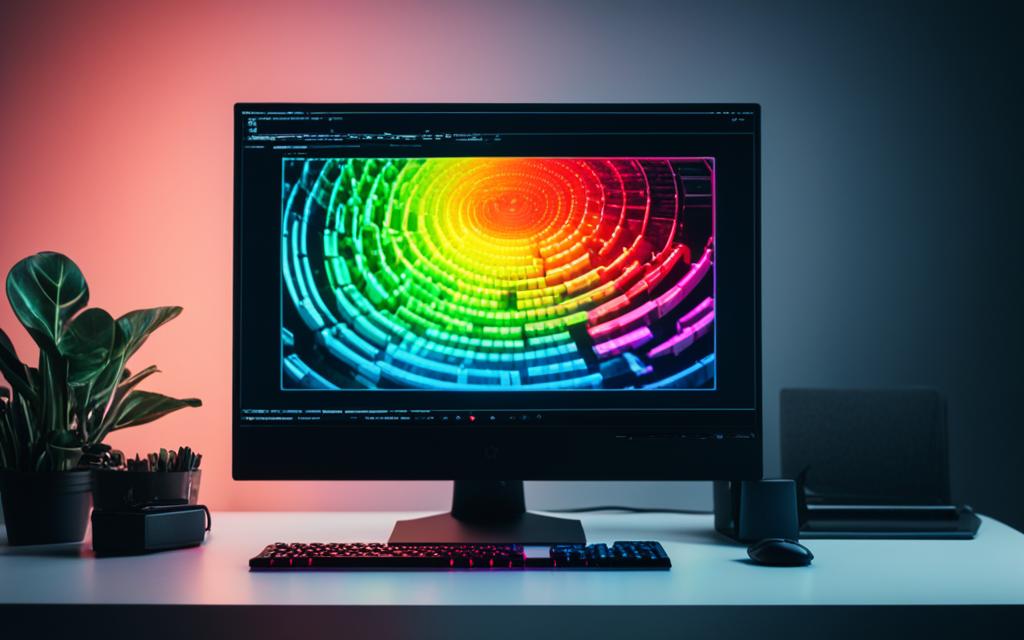Table of Contents
RGB lights have grown popular in gaming PCs, adding a lively touch. But some might want to turn them off for reasons like reducing distractions or saving power. Turning off the LEDs is easy and can be done in a few steps.
You can turn off RGB lighting on your PC in three ways: using software, adjusting the motherboard, or changing BIOS settings. Each method has its advantages. Let’s dive into them.
Disabling RGB Lighting through Software
Controlling RGB lights is simple with the right software. These programs let you change colours, adjust brightness, and set your lighting just how you like it. It’s an easy way to manage your PC’s look.
Many software options are available, supporting various motherboard brands. Popular ones include OpenRGB, JackNet RGB Sync, and CORSAIR Utility Engine (iCUE). There are also options like Aura RGB, HP Omen Gaming Hub, and Gigabyte RGB Fusion.
With these apps, turning off RGB lighting is a breeze. You can also create custom lighting effects to make your PC unique.
Disabling RGB Lighting through the Motherboard
Some PCs have RGB lights on the motherboard itself. You can turn these off directly from the hardware. This method might need some knowledge about motherboards and depends on your model.
For some, unplugging the power from the motherboard’s RGB pins works. Always check your motherboard manual or the manufacturer’s site for instructions specific to your model.
Disabling RGB Lighting through the BIOS
For the tech-savvy, the BIOS offers another way to switch off RGB lights. The BIOS is a system that lets you adjust many computer settings. But be careful here, as wrong changes can upset your system.
Turning off RGB lighting in the BIOS differs by motherboard brand and model. It’s best to consult the manual or manufacturer’s website for detailed steps for your system.
Covering the Lights as an Alternative Solution
If you prefer a quick fix, covering the RGB lights works too. Use things like tape or stickers to cover the lights without making software or hardware changes. This is easy to undo if you change your mind later.
Make sure whatever you use to cover the lights doesn’t block any vents. It’s important not to mess with your PC’s cooling system.
Testing the Results and Troubleshooting
After turning off the RGB lights, check to see if it worked as you wanted. Restart your PC and see if the lights are off or dimmed. This verifies your adjustments.
If you run into issues, look at the manufacturer’s guides or online forums for help. There’s plenty of advice out there for troubleshooting.
Key Takeaways
- RGB lights are popular in gaming PCs, offering customizable options1.
- You can disable RGB lighting using software, motherboard settings, or BIOS adjustments1.
- Software offers an easy way to control and customize your PC’s lighting1.
- To turn off motherboard RGB lights, you might need to unplug power or check the manual1.
- BIOS adjustments are for the more technically experienced. Be cautious1.
- Covering lights with tape or stickers is a quick and reversible solution1.
- Always test your settings and troubleshoot if needed after disabling RGB lights1.
Disabling RGB Lighting through Software
Controlling RGB lighting on a computer is simplest through software. By downloading specific software, users can turn lights on or off. They can also change colours and set lighting for different states like sleeping or shut down1. Many software choices exist, including OpenRGB and CORSAIR Utility Engine (iCUE). These options support different hardware and work on Windows, Linux, and Mac1. For the best experience, users should get the latest software version from official websites1.
OpenRGB offers detailed customization for RGB lighting. It lets users control lighting on motherboards, RAM, and more. Users can even manage individual LEDs to create special effects1.
CORSAIR Utility Engine (iCUE) works with many CORSAIR RGB products. Users can design lighting profiles and adjust individual key colours. iCUE also monitors temperature and controls fans1.
Gigabyte RGB Fusion is great for Gigabyte motherboard owners. It adjusts RGB lighting on motherboards and other devices. Users can pick from various lighting modes and match effects across devices1.
If you have HP Envy or Omen motherboards, HP Omen Gaming Hub is your go-to. It controls RGB lighting by adjusting motherboard power connections1. HP Omen Gaming Hub also boosts system performance and customizes gaming gear1.
Different software has unique interfaces and features. It’s wise to check the guides for the best use. Keeping your software updated ensures it works well with new hardware1.
| Software | Compatibility | Features |
|---|---|---|
| OpenRGB | Windows, Linux, Mac | Control RGB lighting across multiple devices, individual LED control, synchronization |
| CORSAIR Utility Engine (iCUE) | Windows | Custom lighting profiles, key customization, synchronization with iCUE-compatible devices, temperature monitoring, fan control |
| Gigabyte RGB Fusion | Windows | Control RGB lighting on Gigabyte motherboards, graphics cards, peripherals, lighting modes, synchronization |
| HP Omen Gaming Hub | Windows | Control RGB lighting on HP Envy and Omen series motherboards, power connection manipulation, system monitoring, performance optimization |
These software solutions let users tailor their RGB lighting. They provide a way to adjust colours and brightness. With them, syncing effects across devices is easy, making for a unique computer look1.
Disabling RGB Lighting through the Motherboard
Some computers, like those in the Hewlett Packard Envy and Omen series, feature RGB lighting. This lighting illuminates the logo and the inside of the tower. Users can switch off this lighting by disconnecting the power from certain pins on the motherboard1.
Each connection on the motherboard is marked with an abbreviation. For instance, PWRBTN stands for the power button, and LED indicates the RGB lights. By detaching the wire linked to the LED or unplugging from the RGB_HEADER, users can successfully disable the RGB lighting. To find the specific pins for the RGB lighting, always check the motherboard manual available online.
Disabling RGB Lighting through the BIOS
The BIOS settings on a computer can turn off RGB lighting. This requires some know-how and understanding of your motherboard. Users should look at their motherboard manual for how to get into and move around the BIOS settings2.
BIOS often has ways to manage RGB lighting. But, where these settings are and if they’re there at all changes with each motherboard. It’s key to look at the motherboard manual or the manufacturer’s website for guidance on finding the RGB lighting settings in the BIOS2.
In the BIOS settings, you can find and turn off the RGB lighting options. Changing firmware or software settings to stop the LED is not a good idea, say computer engineers. The LED shows hard drive activity, which is useful2.
Looking through the BIOS might scare beginners. Yet, with the right advice, turning off RGB lighting is possible. It’s smart to get to know the BIOS interface and what options are there before changing anything2.
Disabling RGB through BIOS: Step-by-Step Guide
- Look at the motherboard manual or go to the manufacturer’s website for help getting into the BIOS settings.
- Start the computer and press a specific key (like F2, Delete, or F10) to enter the BIOS.
- Find the RGB lighting settings in the BIOS interface. They are often under “Peripheral” or “Advanced” tabs.
- Turn off the RGB lighting using the right option. The exact words will change with different motherboards.
- Save your changes and exit the BIOS to make them take effect.
Following these steps will let users turn off RGB lighting in the BIOS easily2.
Not all motherboards let you turn off RGB lighting through the BIOS. Some don’t have direct BIOS control but offer software instead2. In those cases, look into software like OpenRGB, JackNet RGB Sync, CORSAIR Utility Engine (iCUE) Software, and others like Aura RGB LED lighting, HP Omen Gaming Hub. Also consider Amd Ryzen Wraith Prism RGB Lighting Control Software, Gigabyte RGB Fusion, Cooler Master, or Thermaltake for solutions1.
Covering the Lights as an Alternative Solution
If you don’t want to turn off the RGB lighting through software or your motherboard, you can simply cover the LED lights. You can use electrical tape or special stickers designed for this purpose. This method won’t turn the lights off completely, but it will make them less bright. You can find stickers that not only dim the lights but also look good. Still, remember, this might not be a long-term fix and might not block all the light.
Products like Light Dims offer stickers for dimming LED lights, with different levels of darkness. These stickers are easy to use for controlling light brightness without having to change your setup. Light Dims comes in variety packs, including different shapes and a sheet you can cut3. This lets you customize the fit for different gadgets and appliances. Also, if you change your mind, Light Dims stickers are easy to remove, offering flexibility.
You can also make your own blackout dot stickers with electrical tape, wax paper, and a hole punch3. This affordable method lets you adjust the light size on various devices and appliances. Placing these stickers over the lights dims them, making the overall lighting softer.
If you’re looking for a quick solution, try transparent tape and a black permanent marker3. Just cover the LED with tape and colour it black. This will reduce the light’s brightness. For an even dimmer effect, use black nail polish on the LED light3.
Before covering LED lights, think about your device’s needs. Some gadgets need air to stay cool, so make sure they can get enough air when you cover the lights. Also, remember that you might still see some light, especially if it’s very bright or the covering isn’t totally dark. It’s a good idea to check how it looks after covering the lights to see if it’s dim enough for you.
Benefits of Covering LED Lights
– 100% of devices with status lights can be adjusted by dimming or covering them3.
– Covering the power LED on an Arduino Uno doesn’t really change how much electricity it uses4.
– People usually prefer simple fixes like duct or gaffer tape to deal with the LED lights, rather than tweaking the electronics4.
– The main reason to switch off LEDs, according to users, is to avoid light disturbances in dark places4.
– A practical tip is to have the LED on during the day and off at night, controlling the light effectively4.
– Encasing the Arduino board helps hide the power LED. Using a separate LED outside for indicating power or status is a strategy many choose4.
– For final designs, opting for a smaller Arduino board or a chip on a stripboard is advised for better functionality4.
– The idea of using a hole-punch for LED lights showcases the inventive solutions from the Arduino community4.
Testing the Results and Troubleshooting
After you turn off the RGB lights on your PC, it’s key to check if the computer runs well. This check helps find any issues early on. Below, you’ll find steps to test your PC and fix any problems.
1. Power On the Computer and Check LED Lights
First, switch on your computer and look at the case’s LED lights. If the RGB lights are off, you did it right. But if the lights are still on, you may have missed a step5.
2. Test Power and Reset Switches
Next, press the power button to see if the PC starts without the LED lights. Also, check the reset switch’s working. If there’s an issue, double-check your steps for turning off RGB lights5.
3. Consult the Motherboard Manual
Run into problems? The motherboard manual is your go-to [source]. It has specific troubleshooting steps for your motherboard. Following the manual can resolve most issues after disabling the RGB lighting.
4. Seek Professional Assistance
Can’t fix it on your own? It’s wise to get help from a pro. Experts can guide you and fix technical problems. They make sure your PC works great, even without RGB lighting.
Testing and fixing issues ensures your PC runs smoothly after disabling RGB lighting. Carefully follow each step, use the resources provided, and seek help if necessary. Addressing problems quickly keeps your computer in top shape.
Summary: Troubleshooting Steps After Disabling RGB Lighting
| Troubleshooting Steps | Reference |
|---|---|
| Power on the computer and check LED lights | 5 |
| Test power and reset switches | 5 |
| Consult the motherboard manual | 5 |
| Seek professional assistance | 5 |
Conclusion
In conclusion, you can turn off your PC’s LEDs in many ways. There are options for everyone, depending on what you like and what your PC can do. You can use software to easily manage RGB lights. This lets you change colours, adjust brightness, and set your preferences6. Some people prefer manual methods, like using keys on the keyboard. They find it tough to turn off the keyboard light on Windows 106. Others use Windows settings or software from keyboard makers. Many find these methods effective6.
If you can’t use software, there are hardware solutions too. You can turn off RGB lights by disconnecting motherboard pins or changing BIOS settings. But, be careful about power sources and wiring connections. You must avoid problems with LED colours7. Sometimes, LEDs have colour issues because of loose connections or broken wires. Fixing or replacing LEDs is vital for even lighting and proper working7.
RGB LEDs are great because they offer many colours. They’re great for decorations, stage lighting, and displays8. There are two types of RGB LEDs, each needing different signals for colour control8. Using things like resistors and Arduino boards, you can precisely control LED brightness. But, you might need to adjust settings based on the LED type8.
To turn off PC LEDs, just follow the instructions and use what’s available. Whether with software, BIOS settings, or tweaks to your hardware, there’s something for every preference. Always check your work and solve any problems you find. This way, you’ll get the look you want for your PC. With the right steps, you can make your PC’s lighting match your style. This helps save energy and keep your space distraction-free.
FAQ
What are the different methods to disable RGB lighting on a computer?
You can turn off RGB lighting on a computer in three main ways. These are through software, the motherboard settings, or the BIOS.
How can I control RGB lighting on my computer through software?
To control RGB lighting, you can download specific software. This software lets you turn lights on or off, change their colours and brightness, and set up how they look. Some top software includes OpenRGB, JackNet RGB Sync, and CORSAIR Utility Engine (iCUE). Others are Aura RGB LED lighting, HP Omen Gaming Hub, and Amd Ryzen Wraith Prism RGB Lighting Control Software. You can also find Gigabyte RGB Fusion, Cooler Master, and Thermaltake useful.
How can I disable RGB lighting on my computer through the motherboard?
To turn off RGB lighting via the motherboard, detach the power from certain pins. Make sure to check your motherboard’s manual to find these pins.
Can I disable RGB lighting on my computer through the BIOS?
Yes, disabling RGB lighting through the BIOS is possible. But, you’ll need more know-how and should refer to your motherboard’s manual. It will help you find and navigate the BIOS settings.
Is there an alternative solution to disabling RGB lighting if the above methods are not feasible?
If other methods don’t work for you, there’s another way. You can cover the LED lights with electrical tape or special dimming stickers. This won’t turn off the lights but can reduce their brightness for those who find them too bright.
What should I do after disabling RGB lighting on my computer?
Once you’ve turned off the RGB lighting, check if everything still works fine. Plug in your computer, switch it on, and see if the LED lights are off. Also, make sure the power and reset buttons work properly without the lights.
Is it recommended to modify chip firmware or software settings to disable the LED?
Editing chip firmware or software settings to turn off the LED is not advised. Computer experts say the LED is important as it shows HDD activity.
Source Links
- https://m.majorgeeks.com/content/page/disable_rgb.html – How to Disable RGB (LED) Lighting on Your Computer
- https://www.thewindowsclub.com/how-to-turn-off-rgb-on-a-windows-11-10-pc – How to turn off RGB on a Windows 11/10 PC
- https://www.cnet.com/health/sleep/how-to-dim-turn-off-led-indicator-lights/ – Dim or kill your devices’ bright LED lights once and for all
- https://forum.arduino.cc/t/possible-to-turn-off-onboard-power-led/58133 – Possible to turn off onboard power LED?
- https://skytechgaming.com/support/troubleshooting/ – Troubleshooting Your PC | Skytech Gaming
- https://softkeys.uk/blogs/blog/how-to-turn-off-keyboard-light-windows-10 – How to Turn Off Keyboard Light Windows 10?
- https://marcled.com/blog/2023/04/05/how-to-fix-led-lights-that-are-different-colors-5-practical-solutions/ – How to Fix LED Lights that Are Different Colors? 5 Practical Solutions – Marcled Blog
- https://www.circuitbread.com/tutorials/how-rgb-leds-work-and-how-to-control-color – How RGB LEDs work and how to control color








